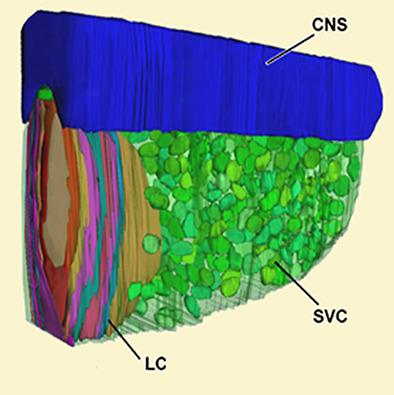当前位置:
X-MOL 学术
›
J. Morphol.
›
论文详情
Our official English website, www.x-mol.net, welcomes your feedback! (Note: you will need to create a separate account there.)
Tail regeneration in a cephalochordate, the Bahamas lancelet, Asymmetron lucayanum
Journal of Morphology ( IF 1.5 ) Pub Date : 2020-11-12 , DOI: 10.1002/jmor.21297 Nicholas D Holland 1 , Ildiko M L Somorjai 2
Journal of Morphology ( IF 1.5 ) Pub Date : 2020-11-12 , DOI: 10.1002/jmor.21297 Nicholas D Holland 1 , Ildiko M L Somorjai 2
Affiliation

|
Lancelets (Phylum Chordata, subphylum Cephalochordata) readily regenerate a lost tail. Here, we use light microscopy and serial blockface scanning electron microscopy (SBSEM) to describe tail replacement in the Bahamas lancelet, Asymmetron lucayanum. One day after amputation, the monolayered epidermis has migrated over the wound surface. At 4 days, the regenerate is about 3% as long as the tail length removed. The re‐growing nerve cord is a tubular outgrowth of ependymal cells, and the new part of the notochord consists of several degenerating lamellar cells anterior to numerous small vacuolated cells. The cut edges of the mesothelium project into the regenerate as tubular extensions. These tubes anastomose with each other and with midline mesodermal canals beneath the regenerating edges of the dorsal and ventral fins. SBSEM did not reveal a blastema‐like aggregation of undifferentiated cells anywhere in the regenerate. At 6 days, the regenerate (10% of the amputated tail length) includes a notochord in which the small vacuolated cells mentioned above are differentiating into lamellar cells. At 10 days, the regenerate is 22% of the amputated tail length: myocytes have appeared in the walls of the myomeres, and sclerocoels have formed. By 14 days, the regenerate is 35% the length of the amputated tail, and the new tissues resemble smaller versions of those originally lost. The present results for A. lucayanum, a species regenerating quickly and with little inter‐specimen variability, provide the morphological background for future cell‐tracer, molecular genetic, and genomic studies of cephalochordate regeneration.
中文翻译:

头脊索动物的尾巴再生,巴哈马柳叶刀,Asymmetron lucayanum
Lancelets (Phylum Chordata, subphylum Cephalochordata) 很容易再生失去的尾巴。在这里,我们使用光学显微镜和串行块面扫描电子显微镜 (SBSEM) 来描述巴哈马刺针 Asymmetron lucayanum 的尾部替换。截肢一天后,单层表皮已迁移到伤口表面。第 4 天时,再生长度约为去除尾长的 3%。再生的神经索是室管膜细胞的管状生长物,脊索的新部分由几个退化的板层细胞组成,位于许多小空泡细胞的前面。间皮的切割边缘作为管状延伸进入再生区。这些管彼此吻合,并在背鳍和腹鳍的再生边缘下方具有中线中胚层运河。SBSEM 没有显示再生中任何地方未分化细胞的胚芽样聚集。在第 6 天,再生(截断尾长的 10%)包括脊索,其中上述小空泡细胞正在分化为层状细胞。第 10 天时,再生为截肢尾长的 22%:肌细胞壁中出现了肌细胞,并且形成了硬化腔。到 14 天时,再生的尾巴长度是被截断的尾巴长度的 35%,新的组织类似于最初丢失的组织的较小版本。A. lucayanum 的当前结果是一种再生快速且样本间变异很小的物种,为未来头脊索动物再生的细胞示踪剂、分子遗传学和基因组研究提供了形态学背景。
更新日期:2020-11-12
中文翻译:

头脊索动物的尾巴再生,巴哈马柳叶刀,Asymmetron lucayanum
Lancelets (Phylum Chordata, subphylum Cephalochordata) 很容易再生失去的尾巴。在这里,我们使用光学显微镜和串行块面扫描电子显微镜 (SBSEM) 来描述巴哈马刺针 Asymmetron lucayanum 的尾部替换。截肢一天后,单层表皮已迁移到伤口表面。第 4 天时,再生长度约为去除尾长的 3%。再生的神经索是室管膜细胞的管状生长物,脊索的新部分由几个退化的板层细胞组成,位于许多小空泡细胞的前面。间皮的切割边缘作为管状延伸进入再生区。这些管彼此吻合,并在背鳍和腹鳍的再生边缘下方具有中线中胚层运河。SBSEM 没有显示再生中任何地方未分化细胞的胚芽样聚集。在第 6 天,再生(截断尾长的 10%)包括脊索,其中上述小空泡细胞正在分化为层状细胞。第 10 天时,再生为截肢尾长的 22%:肌细胞壁中出现了肌细胞,并且形成了硬化腔。到 14 天时,再生的尾巴长度是被截断的尾巴长度的 35%,新的组织类似于最初丢失的组织的较小版本。A. lucayanum 的当前结果是一种再生快速且样本间变异很小的物种,为未来头脊索动物再生的细胞示踪剂、分子遗传学和基因组研究提供了形态学背景。


























 京公网安备 11010802027423号
京公网安备 11010802027423号